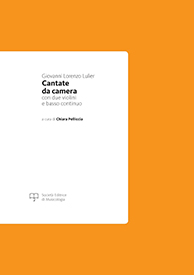© Copyright Società Editrice di Musicologia
Sede legale: Lgt. Portuense 150 - 00153 Roma
C.F. 97701420586
This email address is being protected from spambots. You need JavaScript enabled to view it.
Credits:
Design: Venti Caratteruzzi
Web: StudioBottoni | Giacomo Sciommeri
|
Giovanni Lorenzo Lulier 1. Sarei troppo felice, for Soprano, two violins and continuo XXVIII, 60 p.; 29,7 x 21 cm Giovanni Lorenzo Lulier (ca. 1660 - 1700), also known as Giovanni del Violone, worked in Rome for two major music patrons of his times—Cardinals Benedetto Pamphilj and Pietro Ottoboni. Besides, his name is associated to such stars as violinists Arcangelo Corelli and Matteo Fornari; his musical partnership with them originated Rome's most famous concertino. Lulier's output includes oratorios and chamber cantatas—nothing but vocal music, set to texts by various authors, including his patrons. Although he was a virtuoso, he seems to have written no purely instrumental work. Such fact might be explained by his being active side by side with Corelli, who composed instrumental music only. Volume 2 of Giovanni Lorenzo Lulier's chamber cantatas includes four works for voice, two violins, and continuo. They were not born as a homogeneous group but show interesting connections, besides their common instrumentation. Sarei troppo felice and Non vantar tanta bellezza were composed for Cardinal Benedetto Pamphilj on texts he himself had written; the latter, in particular, focuses on a favorite topic of his—the transience of beauty and life. Sarei troppo felice, Non vantar tanta bellezza, and La farfalla appear here in soprano version; an alto one also exists for the last two titles. La farfalla suggests a parallel, then hardly unusual, between amorous desires and the butterfly's slight, irregular flight, as well as between a candle flame and the fire of love passion. Stan soggetti alla fortuna, of which only the alto intonation survives, shares its topic with Non vantar. Throughout, violin writing is distinctive and refined, with imitative counterpoint effects and instrumental refrains. Were these works intended for "the violin to rule," à la Corelli? Perhaps not, yet Lulier's violin writing is redolent of the rich Roman musical milieu, which originated before Corelli and grew around him. Chiara Pelliccia is a music history researcher, currently studying for a Ph.D. at the Roma 2 University. She collaborates to the Società Italiana di Musicologia for the Dizionario degli editori musicali italiani and for the cataloging project, Clori – Archivio della cantata da camera. She also investigated 20th-century periodicals for the Accademia Nazionale di Santa Cecilia, Rome. She has published essays on 17th- and 18th-century cantata and sundry aspects of Rome musical life between 19th and 20th century. She was awarded the International “Prince Ruspoli” Prize (Musicology section) in 2011 for her essay, Giovanni Lorenzo Lulier (c. 1660-1700) e la cantata da camera tra le corti di Benedetto Pamphilj e Pietro Ottoboni. |
Digital Edition - score (Support SEdM)
ISMN: 979-0-705061-11-6
Paper Edition (distribution: www.liberdomus.it)
ISMN: 979-0-705061-25-3
Price: 25€


